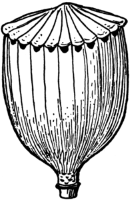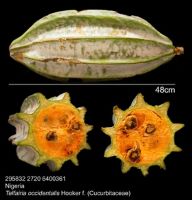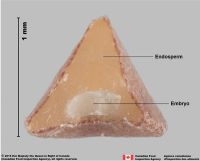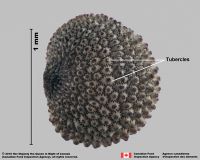Content is from Kirkbride et al. 2006Kirkbride et al. 2006:
Kirkbride JH, Jr, Gunn CR, and Dallwitz MJ. 2006. Family guide for fruits and seeds, vers. 1.0. Accessed September 2020-January 2022. URL: https://nt.ars-grin.gov/seedsfruits/keys/frsdfam/index.cfm ., without modification.
Updates are forthcoming.
Fruits: Pistil(s) compound; with carpels united. Fruit pericarpium; simplesimple:
fruit formed from a single flower with one pistil, solitary carpel or several fused carpels
, or multiplemultiple:
fruit formed from several flowers clustered in one mass
; capsulecapsule:
a dry, dehiscent fruit derived from a compound ovary ; follicetum; poricidalporicidal:
; follicetum; poricidalporicidal:
type of capsular dehiscence, fruit opening by pores or flaps (often near the top) capsulecapsule:
capsulecapsule:
a dry, dehiscent fruit derived from a compound ovary (Spjut has Penthoroideae & 4 families: Campanulaceae, Loganiaceae, Saxifragraceae, Scrophulariaceae), or pyxidium capsulecapsule:
(Spjut has Penthoroideae & 4 families: Campanulaceae, Loganiaceae, Saxifragraceae, Scrophulariaceae), or pyxidium capsulecapsule:
a dry, dehiscent fruit derived from a compound ovary (Spongberg has Penthoroideae, but Spjut has Vahlia), or septicidalsepticidal:
(Spongberg has Penthoroideae, but Spjut has Vahlia), or septicidalsepticidal:
type of capsular dehiscence, opening longitudinally by separating between the septa of adjacent carpels
 capsulecapsule:
capsulecapsule:
a dry, dehiscent fruit derived from a compound ovary (not Spjut), or loculicidalloculicidal:
(not Spjut), or loculicidalloculicidal:
type of capsular dehiscence, opening longitudinally through the locules (compare septicidal)
 capsulecapsule:
capsulecapsule:
a dry, dehiscent fruit derived from a compound ovary (not Spjut); capsulecapsule:
(not Spjut); capsulecapsule:
a dry, dehiscent fruit derived from a compound ovary not inflated; capsulecapsule:
not inflated; capsulecapsule:
a dry, dehiscent fruit derived from a compound ovary without operculumoperculum:
without operculumoperculum:
a dehiscent cap (or lid) of a seed or fruit that opens during germination or dehiscence
 ; without persistent central column; 1-seeded to many-seeded; 1-seeded (to many); with 2(–8)-carpellate (2–4(-8)); with carpels united; with carpels remaining united at maturity; with carpels not radiating at maturity; without sterilesterile:
; without persistent central column; 1-seeded to many-seeded; 1-seeded (to many); with 2(–8)-carpellate (2–4(-8)); with carpels united; with carpels remaining united at maturity; with carpels not radiating at maturity; without sterilesterile:
lacking male and/or female reproductive parts; also, not producing fruit or seed
 carpels; not sulcatesulcate:
carpels; not sulcatesulcate:
surface relief—having one or more elongate, relatively narrow and shallow depressions or grooves ; in transectiontransection:
; in transectiontransection:
a cross section; representing a plane made by cutting across an organ at a right angle to its length tereteterete:
tereteterete:
approximately circular in cross section; width and thickness approximately equal
 ; apexapex:
; apexapex:
the point farthest from the point of attachment, or the "tip" of an organ beaked; dehiscentdehiscent:
beaked; dehiscentdehiscent:
(v. dehisce) splitting open at maturity to release contents (of a fruit) , or indehiscentindehiscent:
, or indehiscentindehiscent:
not opening on its own, as in a fruit
 (rarely). Dehiscentdehiscent:
(rarely). Dehiscentdehiscent:
(v. dehisce) splitting open at maturity to release contents (of a fruit) unit seed(s). Dehiscentdehiscent:
unit seed(s). Dehiscentdehiscent:
(v. dehisce) splitting open at maturity to release contents (of a fruit) at apexapex:
at apexapex:
the point farthest from the point of attachment, or the "tip" of an organ , or base; and shedding seeds; without replumreplum:
, or base; and shedding seeds; without replumreplum:
the rim, formed by the persistent placentas, and connected by a false septum in Brassicaceae fruits. The fruit valves are attached to this rim and separate from it in dehiscent fruits.
. Epicarpepicarp:
outer layer of fruit wall or pericarp, if divided into layers; note here used synonymously with exocarp brown (all shades); durable; membranousmembranous:
brown (all shades); durable; membranousmembranous:
texture—extremely thin, pliable, and fairly tough
; glabrousglabrous:
without hairs
; without armature; without wing(s); without apicalapical:
at or pertaining to the end of the seed or fruit distal from its point of attachment (i.e., base)
respiratory hole. Mesocarpmesocarp:
the middle layer of the pericarp, if divided into layers absent. Endocarpendocarp:
absent. Endocarpendocarp:
the inner layer of the pericarp, if divided into layers present; not separating from exocarpexocarp:
present; not separating from exocarpexocarp:
outer layer of fruit wall or pericarp, if divided into layers; note here used synonymously with epicarp ; thinthin:
; thinthin:
having or being of relatively little depth
; not splitting into 1-seeded pyrenes; smooth; without wing; without operculumoperculum:
a dehiscent cap (or lid) of a seed or fruit that opens during germination or dehiscence
 ; without secretory cavities; without mechanism for seedling escape; without grooves; without longitudinallongitudinal:
; without secretory cavities; without mechanism for seedling escape; without grooves; without longitudinallongitudinal:
of or relating to length or the lengthwise dimension
ridges. Funiculusfuniculus:
(alt. funicle) stalk connecting the ovule (later seed) to the ovary (later fruit) placenta short; short without seed bearing hooks (retinacula); not persisting in fruit after seed shed.
short; short without seed bearing hooks (retinacula); not persisting in fruit after seed shed.
Seeds: Arilaril:
(broad sense) appendicular structure that wholly or partly envelops a seed and is produced from or a modification of the funicle, raphe, or outer integument; usually fleshy or pulpy, sometimes spongy or tufted-capillate, often brightly colored absent. Seed circularcircular:
absent. Seed circularcircular:
(of embryo) linear embryo is curved into an "O" shape , or ellipsoidellipsoid:
, or ellipsoidellipsoid:
3D shape—elliptic
; not bowl shaped; not nutlike; without winglike beakbeak:
a usually firm, terminal appendage, sometimes tapered ; without caudatecaudate:
; without caudatecaudate:
tapering to a long, tail-like appendage appendage(s); at maturity with food reserves, or without apparent food reserves; with endospermendosperm:
appendage(s); at maturity with food reserves, or without apparent food reserves; with endospermendosperm:
nutritive starch- and oil-containing tissue present in many seeds ; without canavanine. Sarcotestasarcotesta:
; without canavanine. Sarcotestasarcotesta:
pulpy or fleshy outer layer of the seed coat, simulates aril absent. Testatesta:
absent. Testatesta:
seed coat
 present; without markedly different marginalmarginal:
present; without markedly different marginalmarginal:
at, on, or close to the margin or border
tissue; without fleshyfleshy:
texture—fairly firm and dense, juicy or at least moist, and easily cut
or leatheryleathery:
texture—moderately thick, tough, and very pliable
layer over hard layer; tight, or loose; dulldull:
reflecting only a low proportion of incident light, with no apparent sheen , or shinyshiny:
, or shinyshiny:
uniformly reflecting a high proportion of incident light at all angles ; surface smooth, or unsmooth; surface with discreet raised features, or merged raised features, or depressed features; surface punctatepunctate:
; surface smooth, or unsmooth; surface with discreet raised features, or merged raised features, or depressed features; surface punctatepunctate:
surface relief—dotted with pits or with translucent, sunken glands or with colored dots, similar to pitted ; surface echinate, or granulargranular:
; surface echinate, or granulargranular:
surface relief—having a grainy surface , or papillatepapillate:
, or papillatepapillate:
surface relief—bearing minute, distinct, broad-based projections, tapering to a rounded apex , or tuberculatetuberculate:
, or tuberculatetuberculate:
surface relief—bearing small, warty, swelling, rounded, or variously shaped projections ; surface reticulatereticulate:
; surface reticulatereticulate:
surface relief—netted, raised walls or concave grooves forming a net-like surface pattern with flat, concave, or convex interspaces , or ridgedridged:
, or ridgedridged:
surface relief—raised, thick ridges, sharp edged or rounded, usually in a series that may cover the entire surface , or striatestriate:
, or striatestriate:
surface relief—having fine, parallel lines, grooves or ridges ; without crease or line separating cotyledons from hypocotyl-radicle; without notch along margin where cotyledons from hypocotyl-radicle tip approach each other; without glands; without bristles; glabrousglabrous:
; without crease or line separating cotyledons from hypocotyl-radicle; without notch along margin where cotyledons from hypocotyl-radicle tip approach each other; without glands; without bristles; glabrousglabrous:
without hairs
; without wings, or with wing(s); 1-winged; with wing encompassing seed; without collar; without operculumoperculum:
a dehiscent cap (or lid) of a seed or fruit that opens during germination or dehiscence
 ; colored; monochrome; black, or brown (all shades), or red; crustaceouscrustaceous:
; colored; monochrome; black, or brown (all shades), or red; crustaceouscrustaceous:
texture—thin, dry, indurate, and brittle
, or thinthin:
having or being of relatively little depth
; not becoming mucilaginousmucilaginous:
resembling mucilage; moist and sticky
when wetted; surrounding food reserve. Rapheraphe:
a ridge or seam on the seed coat, formed by the portion of the funiculus united to the ovule wall in longitudinally curved ovules conspicuous, or inconspicuous; texture as testatesta:
conspicuous, or inconspicuous; texture as testatesta:
seed coat
 ; shorter than seed (assumed); included in dehisced fruit. Endospermendosperm:
; shorter than seed (assumed); included in dehisced fruit. Endospermendosperm:
nutritive starch- and oil-containing tissue present in many seeds development cellular, or helobial, or nuclear (Francoa); copious; fleshyfleshy:
development cellular, or helobial, or nuclear (Francoa); copious; fleshyfleshy:
texture—fairly firm and dense, juicy or at least moist, and easily cut
; smooth; without starch; with oils; without fatty acid containing cyclopropene; without apicalapical:
at or pertaining to the end of the seed or fruit distal from its point of attachment (i.e., base)
lobes; without chlorophyll; without isodiametric faceted surface; without odor. Embryo differentiated from food reserve; well developed; 1 per seed; partially filling testatesta:
seed coat
 (with food reserve); 0.5–1 times the length of food reserve; at one end of seed not extending into a depression or cup; axileaxile:
(with food reserve); 0.5–1 times the length of food reserve; at one end of seed not extending into a depression or cup; axileaxile:
on or of the axis
and centric; linearlinear:
(shape) long, narrow, and uniform in width; (of embryo) embryo is straight and much longer than wide , or foliatefoliate:
, or foliatefoliate:
appearing leaf-like
, or miniature; with spatulatespatulate:
2D shape—like a spatula; rounded at the apex, with base long and tapered; (of embryo) embryo is straight and axile and centric with the cotyledons expanded to form the shape of a spatula or spoon; (of cotyledons) cotyledons expanded and wider than the stalk but not invested into the stalk cotyledons; dwarf (according to Martin for some spp. also could be linearlinear:
cotyledons; dwarf (according to Martin for some spp. also could be linearlinear:
(shape) long, narrow, and uniform in width; (of embryo) embryo is straight and much longer than wide ); straight; parallel to seed length; embedded in endospermendosperm:
); straight; parallel to seed length; embedded in endospermendosperm:
nutritive starch- and oil-containing tissue present in many seeds ; with cotyledons abruptly connected to hypocotyl-radicle, or gradually connected to hypocotyl-radicle; without coleorhiza; without simmondsin; without stomata; not green; with 2 or more cotyledons. Cotyledons 2; moderately developed, or well developed, or tiny; 0.1–0.7 times length of embryo; as wide as hypocotyl-radicle, or somewhat to significantly wider than hypocotyl-radicle; 1–2 times wider than hypocotyl-radicle; not concealing hypocotyl-radicle; not foliaceous; thinthin:
; with cotyledons abruptly connected to hypocotyl-radicle, or gradually connected to hypocotyl-radicle; without coleorhiza; without simmondsin; without stomata; not green; with 2 or more cotyledons. Cotyledons 2; moderately developed, or well developed, or tiny; 0.1–0.7 times length of embryo; as wide as hypocotyl-radicle, or somewhat to significantly wider than hypocotyl-radicle; 1–2 times wider than hypocotyl-radicle; not concealing hypocotyl-radicle; not foliaceous; thinthin:
having or being of relatively little depth
; flat; smooth; with apicesapex:
the point farthest from the point of attachment, or the "tip" of an organ entire; with margins separate; basally entire; equal in size; not punctatepunctate:
entire; with margins separate; basally entire; equal in size; not punctatepunctate:
surface relief—dotted with pits or with translucent, sunken glands or with colored dots, similar to pitted dotted. Hypocotyl-radicle moderately developed, or well developed; straight; not thickened.
dotted. Hypocotyl-radicle moderately developed, or well developed; straight; not thickened.
Literature specific to this family: Spongberg, S.A. 1972. The genera of Saxifragaceae in the southeastern United States. J. Arnold Arbor. 53(4):409–498; Krach, J.E. 1976. Samenanatomie der Rosifloren I. Die Samen des Saxifragaceae. Bot. Jahrb. Syst. 97:1–60.
General references: Baillon, H.E. 1866–95. Histoire des plantes, 13 vols. Hachette & Co., Paris, Corner, E.J.H. 1976. The seeds of Dicots, esp. vol. 2. Cambridge University Press, New York, Cronquist, A. 1981. An integrated system of classification of flowering plants, 1,262 p. Columbia University Press, New York, Engler, A. & K. Prantl. 1924 and onward. Die Natürlichen Pflanzenfamilimien. W. Engelman, Leipzig, Gaertner, J. 1788–1805. De fructibus et seminibus plantarum. The Author, Stuttgart, Goldberg, A. 1986 (dicots) & 1989 (monocots). Classification, evolution, and phylogeny of the familes of Dicotyledons. Smithsonian Contr. Bot. 58 for dicots (314 pp.) & 71 for monocots (74 pp.). [Goldberg's illustrations are reproduced from older publications and these should be consulted], Gunn, C.R., J.H. Wiersema, C.A. Ritchie, & J.H. Kirkbride, Jr. 1992 & amendments. Families and genera of Spermatophytes recognized by the Agricultural Research Service. Techn. Bull. U.S.D.A. 1796:1–500, LeMaout, E. & J. Decaisne. 1876. A general system of botany, 1,065 p. Longmans, Green, & Co., London, Mabberley, D.J. 1987. The plant-book, 706 p. Cambridge University Press, Cambridge, Martin, A.C. 1946. The comparative internal morphology of seeds. Amer. Midl. Naturalist 36:513–660, Schopmeyer, C.S. 1974. Seeds of Woodywoody:
texture—consisting mainly of indurate lignified tissues, characteristic of or resembling wood
plants in the United States. Agric. Handb. 450:1–883, Spjut, R.W. 1994. A systematic treatment of fruit types. Mem. New York Bot. Gard. 70:1–182, and Wood, C.E., Jr. 1974. A student's atlas of flowering plants: Some dicotyledons of eastern North America, 120 pp. Harper & Row, New York.